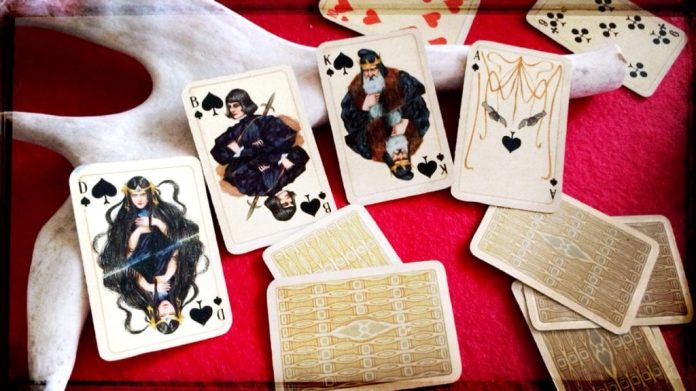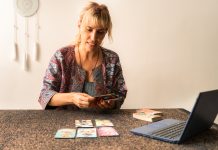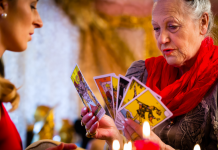In cartomancy readings, psychics use a deck of cards to discern information and discover insights regarding your past, your present or your future, or to answer your specific questions. If your questions primarily relate to romantic issues, a cartomancy reading can be especially insightful.
Usually, a common deck of 52 poker or bridge playing cards with four of the suits including the diamonds, hearts, clubs and spades with the typical cards numbered two through ten plus the Jack, Queen, King, and Ace in each suit is used for a cartomancy reading. Jokers and blank cards can also be added. Each of the suits, numbers, and face cards have meanings that can be related to your questions or specific situation.
Cartomancy readings are a type of future-telling, or divination. Like all types of spiritual readings, they reveal hidden truths and patterns in your present, past or in your future.
The common 52-card deck has been used since the 14th century. It’s believed that this deck type was developed for use in cartomancy readings, and then later for recreational games.
Cartomancy readings can offer a unique experiences for both the reader as well as the person who is seeking guidance from the reading. Playing cards are generally more specific in the type of answers they deliver than tarot cards are. This makes a cartomancy reading a superior resource for getting answers to specific questions. Tarot cards are generally recognized as a good resource to provide information about potential outcomes, or feelings surrounding a certain situation.
Some people feel that cartomancy readings can be a little too honest and that they don’t leave enough room for the reader’s interpretation. Math and numbers do come into play in cartomancy readings and even though tarot readings involve numerology too, they are far less straightforward than in cartomancy readings.
Cartomancy readings do share some similarities with tarot readings. They’re both based on cards with meaningful symbols that are to be interpreted to answer specific questions and to clarify future possibilities. The deck of 52 playing cards may have evolved from traditional tarot decks’ 56 minor arcana cards. In some cartomancy readings, the reader links each of the four suits in the deck to an element of astrology in this way: hearts to water, spades to air, diamonds to earth and clubs to fire. Other readers have different connections and interpretations, which are based on their own expertise and experiences.
Like a tarot readings, a cartomancy reading depends on the experience of a psychic reader who is able to interpret and relate the card’s patterns to the circumstances and person’s life. There’s no one interpretation that will be right for everybody.
Since there are thousands of card patterns and interpretations, just about any topic can be explored in a cartomancy reading. A psychic could spend hours analyzing a spread, or you could keep it simpler with quick yes-or-no questions.
A cartomancy reading may be a good option for you if you have general concerns about your future, if you have specific questions about if and when a certain event will occur, about possible next steps in a relationship, or when to make a move in your career.
Psychics can perform online cartomancy readings similar to the way they would perform basic readings or tarot readings by telephone. You can ask the reader your question, and the reader will give guidance and answers based on the card spread that is laid.





The astrology element associations with the suits in cartomancy are a new insight for me. It appears each reader may have their own methods, which makes it a personalized experience.
The ability of psychics to perform cartomancy readings online shows the flexibility of the practice. It’s convenient for those who seek guidance but cannot meet in person.
The mention that cartomancy readings can be ‘too honest’ is quite intriguing. I wonder how this compares to the subjective nature of tarot readings.
Ah yes, because the best way to navigate life’s complexities is clearly through a game of 52 Pickup with a fortune-teller. Who needs practical solutions when you have cards, right?
The article provides a comprehensive overview of cartomancy and its distinctions from tarot readings. It seems the precision of playing cards can offer a different perspective compared to tarot cards.
The accuracy and honesty of cartomancy can be a double-edged sword. It’s refreshing to have a reading that doesn’t sugarcoat the truth, though it can be challenging to hear.
The historical aspect of using playing cards for divination dates back to the 14th century. This longevity suggests there might be some merit to it, or at the very least, it serves as a cultural artifact worth exploring.
History aside, it’s curious to see how these practices have survived into modern times. There’s a certain allure to the ancient combined with the new.
Indeed, Dragon. The intersection of history and mysticism is always intriguing. It’s worth noting how cultural practices evolve yet remain rooted in their origins.
Are we really still entertaining the idea that shuffling a deck of cards can predict our future? This article reads like a relic from a bygone era.
While I understand your skepticism, Debra, I believe there is a lot of value in the symbolic interpretations that cartomancy offers. Perhaps it’s less about predicting the future and more about introspection and self-awareness?
It’s interesting to learn about the historical context of the 52-card deck and its application in cartomancy. The evolution from minor arcana cards to playing cards is quite fascinating.
Fascinating article! It’s remarkable how a simple deck of cards can carry so much symbolism and insight. I’ve always been intrigued by the history and depth of cartomancy.
Comments are closed.